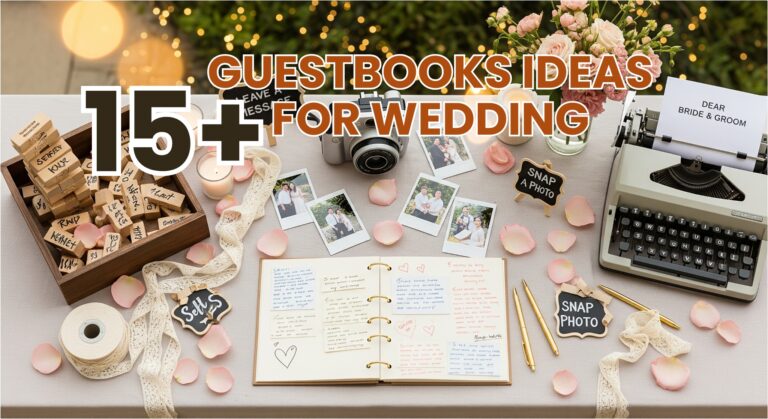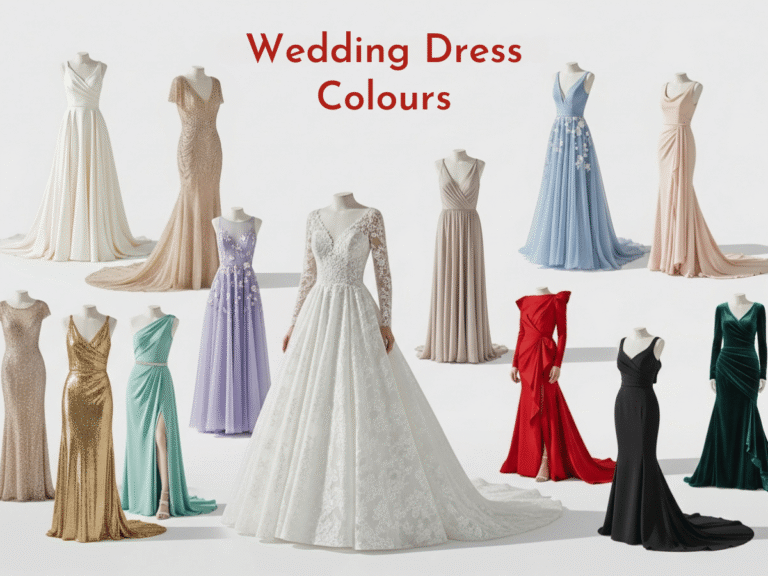Wedding Dress Fabrics and Materials: Complete Guide
Choosing the right fabric is as crucial as selecting the perfect wedding dress styles. Fabrics define a gown’s texture, movement, and overall style. From luxurious silks to delicate lace, each material shapes the dress’s drape, comfort, and visual impact. Understanding the characteristics of different wedding dress fabrics ensures you select a gown that complements your body shape, necklines & sleeves, wedding theme, and personal style.
This guide explores the most popular bridal fabrics, their unique properties, advantages, disadvantages, and the types of wedding dresses they best suit. Whether you’re drawn to ethereal layers of tulle or the structured elegance of mikado, this guide will help you make an informed decision.
Table of Contents
Why Wedding Dress Fabrics Matter
Fabrics are the foundation of a bridal gown. While embellishments, lace, and beadwork create personality, the fabric determines the dress’s shape, flow, and overall feel.
Key considerations include:
- Silhouette and Structure: Structured fabrics like mikado or satin hold their shape for dramatic gowns, while chiffon or tulle create soft, flowing dresses.
- Movement and Comfort: Lightweight fabrics allow ease of walking, dancing, and sitting, whereas heavier fabrics can feel formal or restrictive.
- Seasonal Suitability: Fabrics like silk, velvet, or brocade are warm for winter weddings, while organza, tulle, or chiffon are breathable for warmer climates.
- Style and Aesthetic: The fabric influences how the dress looks in photos and in motion, from romantic lace overlays to modern, minimalist satin finishes.
By understanding fabric properties, brides can select a gown that perfectly complements their body shape, venue, and personal style.
Popular Wedding Dress Fabrics
Selecting the right fabric is crucial in defining the overall look, feel, and comfort of your wedding dress. Each fabric offers unique characteristics that can enhance different silhouettes and suit various wedding themes. Below is an in-depth look at the most popular wedding dress fabrics:

1. Lace
Lace is a delicate, open-weave fabric often featuring intricate floral or geometric patterns. It adds a romantic and vintage touch to bridal gowns.
Best For: A-line, sheath, ball gown, and mermaid silhouettes.
Pros:
- Timeless and elegant appearance.
- Adds texture and depth to the gown.
- Versatile for overlays, sleeves, and veils.
Cons:
- It can be delicate and may require careful handling.
- May need lining for modesty or comfort.
Season & Venue: Suitable for all seasons; ideal for traditional, vintage, or garden weddings.

2. Satin
Satin is a smooth, glossy fabric known for its luxurious sheen. It drapes beautifully and holds its shape well, making it a popular choice for formal bridal gowns.
Best For: Ball gowns, A-line dresses, and other structured silhouettes.
Pros:
- Elegant and sophisticated appearance.
- Holds structure and shape effectively.
- Photographs beautifully due to its sheen.
Cons:
- It can be heavy and may not be breathable.
- Prone to creasing and may require frequent steaming or pressing.
Season & Venue: Best for fall and winter weddings; suitable for formal indoor venues.

3. Tulle
Tulle is a lightweight, sheer fabric that adds volume and a dreamy, ethereal quality to bridal gowns.
Best For: Ball gowns, A-line dresses, and skirts requiring added volume.
Pros:
- Creates a voluminous effect without adding weight.
- Ideal for layered skirts and veils.
- Offers a whimsical and romantic aesthetic.
Cons:
- It can be delicate and may snag easily.
- May require additional layers for opacity.
Season & Venue: Perfect for spring and summer weddings; suitable for outdoor or fairytale-themed venues.

4. Chiffon
Chiffon is a soft, lightweight fabric with a slightly crinkled texture. It drapes elegantly and moves fluidly, offering a graceful silhouette.
Best For: Sheath, A-line, and empire waist dresses.
Pros:
- Light and breathable, ideal for warmer climates.
- Flows beautifully and adds movement to the gown.
- Comfortable for long hours of wear.
Cons:
- It can wrinkle easily and may require careful handling.
- May need lining for modesty or to prevent sheerness.
Season & Venue: Suitable for spring and summer weddings; ideal for beach or destination weddings.

5. Organza
Organza is a thin, sheer fabric with a crisp texture. It adds structure and volume to bridal gowns without adding significant weight.
Best For: Ball gowns, A-line dresses, and layered skirts.
Pros:
- Holds shape well, adding structure to the gown.
- Lightweight and breathable.
- Offers a delicate and refined appearance.
Cons:
- It can be stiff and may not drape as softly as other fabrics.
- May require careful handling to avoid wrinkles.
Season & Venue: Suitable for spring and summer weddings; ideal for formal indoor venues.

6. Silk
Silk is a natural fiber known for its luxurious feel and lustrous finish. It drapes beautifully and offers a timeless, classic look.
Best For: Sheath, A-line, and mermaid silhouettes.
Pros:
- Soft and comfortable against the skin.
- Drapes elegantly and moves fluidly.
- Offers a timeless and classic aesthetic.
Cons:
- Expensive and may require careful maintenance.
- It can wrinkle easily and may need frequent steaming.
Season & Venue: Suitable for all seasons; ideal for formal indoor venues.

7. Mikado
Mikado is a blend of silk and nylon, resulting in a fabric that combines the luxurious feel of silk with the durability of nylon. It has a lustrous finish and holds its shape well.
Best For: Ball gowns, A-line dresses, and structured silhouettes.
Pros:
- Holds structure and shape effectively.
- Offers a luxurious feel without being overly heavy.
- Photographs beautifully due to its sheen.
Cons:
- It may not be as breathable as natural fibers.
- It can be more expensive due to its composition.
Season & Venue: Best for fall and winter weddings; suitable for formal indoor venues.

8. Crepe
Crepe is a fabric with a slightly crinkled texture, offering a matte finish. It drapes beautifully and provides a sleek, modern silhouette.
Best For: Sheath, A-line, and column dresses.
Pros:
- Sleek and modern appearance.
- Drapes beautifully and moves fluidly.
- Comfortable for long hours of wear.
Cons:
- May require careful handling to avoid wrinkles.
- It can be heavier than other lightweight fabrics.
Season & Venue: Suitable for all seasons; ideal for modern or minimalist-themed weddings.

9. Velvet
Velvet is a soft, plush fabric with a rich texture. It offers a luxurious and opulent appearance, making it a popular choice for winter weddings.
Best For: Ball gowns, A-line dresses, and other formal silhouettes.
Pros:
- Rich and luxurious appearance.
- Warm and comfortable for cooler climates.
- Adds depth and texture to the gown.
Cons:
- It can be heavy and may not be breathable.
- Prone to crushing and may require careful maintenance.
Season & Venue: Best for fall and winter weddings; suitable for formal indoor venues.

10. Jacquard/Brocade
Jacquard and brocade are woven fabrics featuring intricate patterns, often with a raised texture. They add a regal and ornate touch to bridal gowns.
Best For: Ball gowns, A-line dresses, and other formal silhouettes.
Pros:
- Intricate patterns add depth and interest.
- Durable and holds shape well.
- Offers a regal and opulent appearance.
Cons:
- It can be heavy and may not be breathable.
- Patterns may limit design versatility.
Season & Venue: Best for fall and winter weddings; suitable for formal indoor venues.

11. Net/Point d’Esprit
Net is a lightweight, open-weave fabric, while Point d’Esprit is a type of net with small dots woven into the fabric. Both add a delicate and airy quality to bridal gowns.
Best For: Veils, overlays, and skirts requiring added texture.
Pros:
- Adds delicate texture and dimension.
- Lightweight and breathable.
- Ideal for layering over other fabrics.
Cons:
- It can be delicate and may snag easily.
- May require additional layers for opacity.
Season & Venue: Suitable for all seasons; ideal for vintage or romantic-themed weddings.
Choosing the right fabric for your wedding dress is a personal decision that should align with your style, comfort, and the overall theme of your wedding. Consider the characteristics of each fabric and how they complement your chosen silhouette and wedding setting. Whether you opt for the timeless elegance of lace or the modern sophistication of Mikado, the perfect fabric will make your wedding dress truly unforgettable.

Sophia Lane is a dedicated bridal fashion writer and wedding style consultant with over a decade of experience in helping brides-to-be discover their dream gowns. With a background in fashion journalism and bridal styling, Sophia specialises in writing detailed, research-driven guides on wedding dress styles, fabrics, accessories, and bridal trends.
Her work blends in-depth fashion knowledge, cultural research, and practical advice, ensuring brides receive content that is both inspiring and actionable. She has studied wedding dress history across cultures, analysed emerging eco-friendly bridal trends, and regularly collaborates with designers to stay updated on the latest collections.
Expertise
-
Wedding dress styles, fabrics, and silhouettes
-
Body-shape based bridal styling (petite, plus size, tall, maternity)
-
Sustainable and eco-friendly bridal fashion
-
Bridal accessories, tailoring, and preservation techniques
-
Global cultural wedding attire traditions








11 Comments